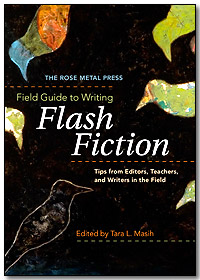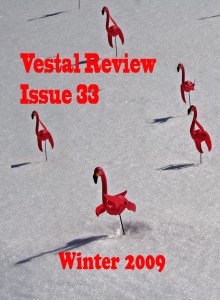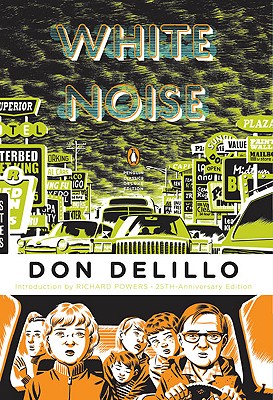 “Alice Munro is mostly known as a short story writer and yet she brings as much depth, wisdom and precision to every short story as most novelists bring to a lifetime of novels.” So Jane Smiley, a judge on the 2009 Man Booker International Prize, told of its beloved Canadian winner last month. It was the first time a writer who exclusively produces short stories was awarded this prestigious prize. Times are turning and shorter forms of fiction are not only finally being given the eminence they deserve, but becoming increasingly more in vogue. It was therefore with keen interest that I picked up The Rose Metal Press Field Guide to Writing Flash Fiction, an unprecedented gathering of 25 brief essays by experts in the field that includes a lively, comprehensive history of the hybrid genre by editor Tara L. Masih.
“Alice Munro is mostly known as a short story writer and yet she brings as much depth, wisdom and precision to every short story as most novelists bring to a lifetime of novels.” So Jane Smiley, a judge on the 2009 Man Booker International Prize, told of its beloved Canadian winner last month. It was the first time a writer who exclusively produces short stories was awarded this prestigious prize. Times are turning and shorter forms of fiction are not only finally being given the eminence they deserve, but becoming increasingly more in vogue. It was therefore with keen interest that I picked up The Rose Metal Press Field Guide to Writing Flash Fiction, an unprecedented gathering of 25 brief essays by experts in the field that includes a lively, comprehensive history of the hybrid genre by editor Tara L. Masih.
As a creative writing professor at Boston College, I frequently use collections of flash fiction, stories which usually run 1000 words or less. Given time limitations and the varying writing experience of my students, these versatile, word-limited pieces are a very approachable and satisfying form to work within. However, I always find myself floundering about when I try to explain and define this genre for the first time. As Pamelyn Casto, one of the thought-provoking, inspiring contributors, puts it: “Flash fiction is difficult if not impossible to define – and should be allowed to remain so – because this type of writing is protean… it takes on various shapes and uses different strategies to achieve its goals.” This is why this collection is so successful, and so essential, to anyone in the field of short fiction who teaches, writes, and is interested in its history and practice. These essays are probing and explorative rather than reductive and constrictive. A true ‘field guide’ in spirit, I came away thoroughly more equipped to teach and write short fiction in a richer, more illuminating way.

Tara L. Masih / Photo Credit: Elizabeth Sullivan
This book is an Aladdin’s cave of gems, a brilliantly versatile guide to invigorate any written piece, any writer’s working life. Flash fiction is the impetus for all these essays, and the fantastic prompts and exercises that each includes, yet most of the commentary and advice can be applied to stimulate and aid any creative writer. For example, Vanessa Gebbie encourages us to try writing freely and continuously, without pausing and censoring our words, in responses to certain prompts, telling us “I have seen whole stories written in this way in a very few minutes. And in my own case, I know that work produced like this has a liveliness that writing I agonize over for days just does not”. Jayne Anne Philips suggests using photos, in particular a photo of our parents’ wedding, to produce a one-page fiction piece. Randall Brown challenges us to begin with different types of “encounters – highly charged, interesting, rare.” Lex Williford, who sees flash fiction as “usually begin[ning] in image and end[ing] with something akin to the lyricism of poetry”, ingeniously instructs us to make an “inkblot”, to write down at least ten images from the pattern that it produces, and then to write a 15-minute fiction using as many of the images as we can. Pamelyn Casto invites us to dive into the kingdoms of myth. The book becomes a Field Guide To Stimulating The Imagination and I was thoroughly transformed by the many rainbows of inspiration on the ride.
It is a testament to the book’s impact that I am using it as a set text for my creative writing classes next year. Hopefully the day is not too far away when we will see a flash fiction collection win a prestigious literary prize like the Booker. The best things do often come in small packages.
Further Resources

– Read an excerpt (Click on “Read an excerpt” to download the PDF file) from the Rose Metal Press Field Guide to Writing Flash Fiction.
– Boston-based writers: Join Tara L. Masih for a one-day seminar, The Rise of Flash Fiction: History and Practice, at Grub Street on July 18, 2009 from 9 AM-4PM. Click here for a course description and further details. Grub Street is located at 160 Boylston St., 4th floor, Boston, MA 02116. Call 617-695-0075 to register.
– New York-based writers: Attend the Asian American Writers’ Workshop’s “Flash Fest,” from July 22-23. (Click on the link for details.) Masih will teach a workshop on flash fiction on the 22nd and read with Shouhua Qi (one of the Field Guide‘s contributors), and Nina Sharma on the 23rd. The second night is FREE and open to the public: join for a flash contest based on the stories completed in the previous night’s workshop, which will be read by local actors and voted on by the audience.
The AAWW is located at 16 West 32nd St., Suite 10A, New York, NY.
– Flash writers anywhere: Once you’ve picked up a copy of the Field Guide, submit your own flash fiction story (inspired by one of the book’s exercises) for possible publication on the editor’s Field Guide Flashes page.
– Check out the Vestal Review, a flash fiction lit magazine (print, but with some stories available online), now in its 33rd issue.





